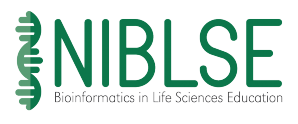Resources
Sequence Similarity: A Quick Introduction to Bioconductor
Author(s): Derek Edward Sollberger
UC Merced School of Natural Sciences
835 total view(s), 910 download(s)
Module3R_-_student.docx(DOCX | 17 KB)
Module3R_-_student.html(HTML | 746 KB)
Module3R_-_student.pdf(PDF | 219 KB)
Module3R_-_student.rmd(RMD | 10 KB)
Module3R_-_teacher.docx(DOCX | 17 KB)
Module3R_-_teacher.html(HTML | 748 KB)
Module3R_-_teacher.pdf(PDF | 218 KB)
Module3R_-_teacher.rmd(RMD | 12 KB)
Teaching Notes_-_Derek Sollberger.docx(DOCX | 14 KB)
- Sequence Similarity: An inquiry based and "under the hood" approach for incorporating molecular sequence alignment in introductory undergraduate biology courses | CourseSource
- License terms
Description
In this bioinformatics adventure, we are going to continue to look amino acid sequences and compute similarity scores using the BLOSUM62 matrix, but we will take a glimpse at some of the tools that are available in the world of Bioconductor. This set of tasks are set after Exercise 3 in the Sequence Similarity materials
Bioconductor is a collection of R packages that has been built by several bioinformatics researchers to perform common calculations in their field. In their own words, ``Bioconductor provides tools for the analysis and comprehension of high-throughput genomic data. Bioconductor uses the R statistical programming language, and is open source and open development. It has two releases each year, and an active user community.’’
Notes
- Introduce students to the Bioconductor suite of R packages
- Perform sequence similarity calculations
Reference
Kleinschmit, A., Brink, B., Roof, S., Goller, C., and Robertson, S.D. 2019. Sequence Similarity: An inquiry based and “under the hood” approach for incorporating molecular sequence alignment in introductory undergraduate biology courses. CourseSource. https://doi.org/10.24918/cs.2019.5
Cite this work
Researchers should cite this work as follows:
- Sollberger, D. (2021). Sequence Similarity: A Quick Introduction to Bioconductor. Bring Bioinformatics to Your Biology Classroom, QUBES Educational Resources. doi:10.25334/WTAG-3Y84

